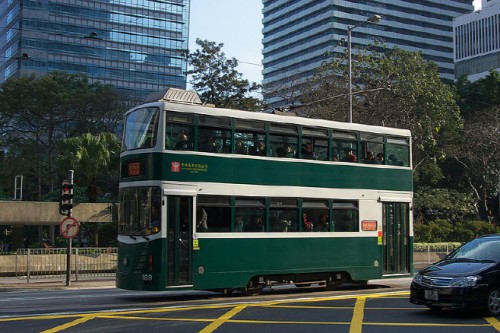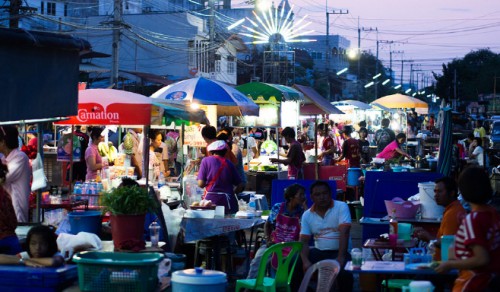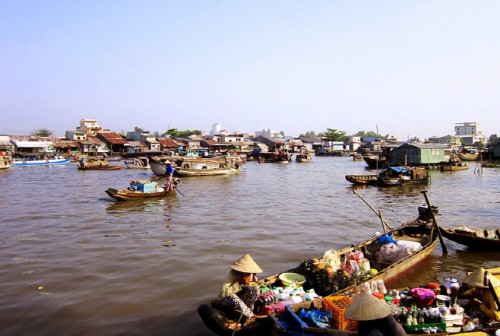 |
| Hong Kong's tram./ Source: Wikimedia commons |
By AsiaToday reporter Kim Eun-young - Asia's rapid growth and urbanization are jeopardizing the existence of major tourist draws that have long been part of the local people's lives.
The Singapore Straits Times (ST) expressed concern on Sunday about whether Hong Kong's famous trams will survive the competition of faster and more effective transportation in the future, and that its operator Hong Kong Tramways is making all efforts to make trams stay in service.
According to the ST, Hong Kong's 110-year-old trams are currently seeking to renovate the image in various ways. The tram's logo, which has been in use since 1974, will be replaced with a new logo later this month.
Mr Emmanuel Vivant, managing director of Hong Kong Tramways, told local newspaper South China Morning Post earlier this month: "We are currently rethinking its visual identity to emphasize the emotional link with the Hong Kong public and fully reflect its iconic value."
In addition, the company has upgraded its infrastructure to reduce noise for both riders and residents and office workers near the tracks. Besides, a smartphone app has been introduced to provide information such as tram arrival times and the nearest stop to keep pace with the digital age.
Some argue that trams should be removed from the central business district since they take up 30% of the road space and cause traffic congestion, but many people who have a strong love for trams are opposed to these claims, the ST reported. Trams, nicknamed 'ding ding' by local people, are used by about 200,000 passengers a day.
Vivant told SCMP: "As the city's public transport industry is highly competitive, we are seeking to continuously improve the service. We have a big responsibility to preserve the heritage of trams. If you remove trams in Hong Kong, you remove the heart of Hong Kong."
 |
| The street food vendors selling street food in Thailand./ Source: Wikipedia |
Thailand is banning Bangkok's world famous street food as a part of the city renewal initiative. According to the AFP report, the chief adviser to Bangkok's governor, Wanlop Suwandee, said on Apr. 18, "The Bangkok Metropolitan Administration (BMA) is now working to get rid of the street vendors from all 50 districts of Bangkok and return the pavements to the pedestrians. All kinds of stalls will be banned to promote citywide order and hygiene."
AFP reported that about two-thirds of the 30,000 street vendors in Bangkok have already been demolished or relocated from pavements for reasons of pedestrians' inconvenience and traffic congestion, citing city officials.
However, many people believe that street stalls are one of Bangkok's charms because even though they are a bit chaotic, they provide delicious food at reasonable price. "If you want to clean out all the vendors it's like you are cleaning out our culture itself," said Chiwan Suwannapak, a resident in Bangkok.
 |
| Vietnam's Cai Rang floating market./ Source: Wikimedia commons |
In Vietnam, the number of floating markets in Mekong Delta is decreasing due to rapid pace of development and urbanization. According to diplomatic magazine The Diplomat, the floating markets are where boats full of fruits, flowers, and handicrafts gather to trade their goods and have long been representing the identity and traditions of local residents.
But as the government began to build massive river dikes and sluice gates to prevent floods in the 1990s and mid-2000s, merchants were no longer able to freely move their boats to the floating markets, and many of them had to leave for other businesses.
Rapid urbanization is also threatening the existence of the floating markets. The role of river traffic and floating markets has been further reduced with the emergence of air-conditioned modern supermarkets and expansion of transportation infrastructure. According to the media, Cai Rang floating market - the largest market in the region - stretched about 2 kilometers along the junction of the Cai Rang River and the Hau River 10 years ago, but now the market's size has halved.
#Asia #tourist draw #urbanization #Hong Kong #trams
Copyright by Asiatoday
Most Read
-
1
-
2
-
3
-
4
-
5
-
6
-
7





















